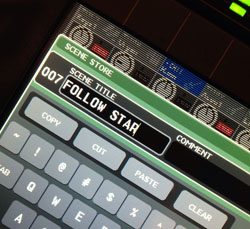Saving and recalling mix settings are a tremendous benefit provided by digital consoles, particularly for church sound operators. Called “scenes” or “snapshots,” they make for quick changes (volume, EQ, effects, etc.) at the touch of a button. Are they worth the time to set up? Most definitely.
Growing up on an analog mixer, I didn’t have the benefit of saving and recalling scenes. At best, I had…well, nothin’. It came down to making notes on the worship service schedule and twisting knobs as fast as I could when we’d go from one song to the next. Then came digital mixers offering scenes capabilities.
Would I need it? How much did those song mixes really change? Upon reflection, more than I realized at the time. I’ve found four primary benefits to using scenes/snapshots, no matter how many services there are each weekend:
1) Recalling a scene in case of a problem. For example, you might change up a mix so much that you don’t like the result. No problem, recall the original mix.
2) Continual improvements from week-to-week. You might have the same band each weekend. While song mixes can change, you can still work out a vocal or instrument channel sound that’s not quite what you want.
3) Producing the best mix for each song, not a compromise. In the analog world, yes, it’s possible to make mix changes from song to song. Even a lot of professionals still run on analog, and this is part of their process. However, if there’s the ability to set a separate mix for each song that can be recalled instantly, then why not use it?
4) As a training aid. Volunteers can be trained using saved mixes so they hear the right mix as well as examples of bad mixes. They can also mix during a practice with the always recall your mix at any time.
Here are five tips for using scenes/snapshots, and my apologies if the first one seems simple—it’s important:
1) If scenes/snapshots are available on your mixer then by all means use them. It’s common to believe that a digital mixer has more functionality that you need, but don’t think scene recall is beyond your need.
2) During the service, if your mix changes are “best for the mix,” then save them. We run three services each Sunday at my church, and we want the mix to be right the first time. However, we recognize the presence of the congregation in the room does change the sound of the mix, particularly on the low end. Small mix changes do occur and therefore we save those so they’re present for the next service.
3) If changes are service-specific, don’t save them. A great example is the lead and backing vocals. The worship leader might sing noticeable louder the second service than the first, or vice versa. Keep that base mix and know such changes are natural differences between the services.
4) Save new scenes before you need them. For example, you set the mix for the song “Worthy is the Lamb” and you’re about to mix the next song. Save the same scene into a new slot with the name of the next song before making any new mix changes. This way, you don’t save over the previous scene.
5) Once all scenes are created, copy the final scene and add it as one more scene. In case you accidentally hit the button to advance scenes, you have a built-in safety measure.
The Take Away
Digital mixer scene functionality provides a wealth of benefits not available in analog mixers. Scenes/snapshots are helpful for training, re-setting a mix, and building the best mix for each song.
Remember to save the mix changes that benefit the mix but don’t save the changes that are specific to a service. Once you start using scenes, you’ll never want to go back.
Ready to learn and laugh? Chris Huff writes about the world of church audio at Behind The Mixer. He covers everything from audio fundamentals to dealing with musicians. He can even tell you the signs the sound guy is having a mental breakdown.





















